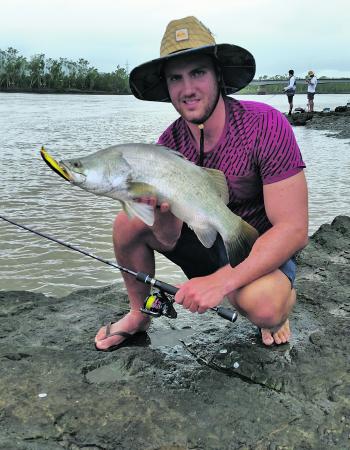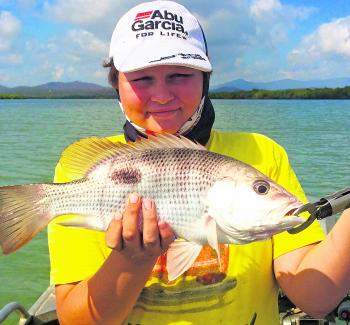What a time we’ve had in recent week. Late rains out west and down the Queensland Coast have turned everything around from the period after Christmas.
The early schools of mackerel have been sent packing to wider grounds and cleaner water. The bay has that silty brown look, which many of the estuary fish don’t mind too much, but most of the others will be slow for a while. In saying that, in recent years when the early flow starts the country just wide of the plume seems to fire up as the fish still get the bonus feed provided by the flood waters and they can stay in the higher level saltwater they prefer.
Sweetlip and grunter will be feeding well on the patches that border the current line. Look for grunter, especially at spots like The Pinnacles, The Rama and Manifold where there is a very good chance of picking up some nice sized nannies as well. Sweeties have already been very active behind the islands and should be stirred up by the weather and ready for another feed.
Fish as lightly weighted as possible, but try and get down to the fish, even if that calls for a move up current so your baits sit in the right area. Prawns will definitely be the bait of choice and will be hard to top. The reef patches on the other side of the islands are running well, as more red emperor and big nannies have been caught in close. Big baits are the key to consistent catches with red fish. Tuskfish, cod, jobfish and hussar are all in good numbers, and anglers don’t have to do the big miles like later in the year.
By now the heat of summer should have dropped slightly and it will signal the coming of the spotted mackerel in fair sized schools. Last month, we were getting a few early spotties at the southern spots out from Emu Park and Keppel Sands. This would normally be a sign that we are in for a big mackerel season inside the bay.
It is hard to really think too much ahead until the river has dropped a little and Keppel Bay clears to its usual blue. Regardless, there will be lots of the smaller mackerel around the islands at all the regular haunts provided we get conditions that allow us to get at them. They should start running at spots like Cape Capricorn and Hummocky before moving into The Keppels. Barren and Child is the most likely spot to score large doggies, greys or spotties and you only need to watch your sounder to locate the schools.
Between Barren and Child is the passage and at either end of the passage is a drop off and lumps of reef. These spots are like magnets to bait schools and that in turn pulls in any pelagics in the area. The best spot out here though is the northeast corner, where there is always an obvious current line over the reef edges. Spaniards, cobia and big sharks seem to love this environment and it is the go-to spot for all newbies targeting large fish.
Anglers will also be looking for bottom fish such as coral trout and other quality reefies. They will be present anywhere you get some sort of current pushing into or past the main features of an island or bommie.
The opening of the barramundi season last month seemed to come on at a new level not seen for many years with stacks of fish around the metre-mark both in town and down the river. This season is something completely different to previous years with the NFZ taking effect. Ever since I began fishing The Fitzroy in the early ‘70s, the majority of fish caught at the beginning of the year were small to just legals, with big fish in relatively low numbers. Over the years the fishing styles have advanced from years gone by the where the majority a barra caught locally were caught throwing hardbodies or live baiting.
Then progression brought in the use of soft plastics and vibes to cover a much wider piece of the country, away from the just working the snag and rock bar mentality. This got anglers into another thought process, and they started to look for fish in many other areas and started having more success. The ability to get into very deep holes and hard up against rock faces took over the next phase.
The new fad that is turning up fish in other locations is slow trolling. This is not new in other areas, but the amount of fish available in the river left us stagnating in old practices. Often thought of as the lazy man’s fishing, most of us never gave it much of a chance.
The threadfin run towards the end of last year and into this year has converted a whole bunch of anglers into giving trolling a go. This has allowed them to fish volumes of territory that previously were left untapped. The fish often move to the deeper channels over the low tide where they wait for all the baits that were spread out on the high to come back off the flats and shallows.
Selecting a lure that runs just a bit shallower than the channel is the best option and even one that touches the bottom occasionally will attract the attention of fish nearby. When the water is clear the more natural colours are the best, and when the water is muddy then fluoro lures should come into play. I prefer a lure that puts out a decent vibe and this can be varied by working your rod tip as you troll. Only time will tell how good it will be in the river, but once we get rain at the beginning of the breeding cycle and a few reasonable recruitments, the Fitzroy River should rival the best barramundi areas anywhere.
King threadfin salmon are still in the best form for years as the big schools continue to dominate most of the action in the bottom end of the river, just outside the heaviest fresh flow. Through Casuarina and down to Port Alma and Connors has not stopped producing serious salmon for months.
Most of these fish have been taken on vibes either trolled or worked over the deeper drop-offs. You need to watch your sounder when searching, because the schools are that thick at times that you can count the hundreds of fish and know exactly where to place your lures.
The live bait anglers set up camp with prawns under floats and have scored good fish along any of the muddy high bank areas towards Connors.
Golden snapper (fingermark) both in the estuaries and offshore have been showing up in lots of catches. Big plastics and vibes seem to be the best option for lures, while they are always susceptible to a well placed live bait.
Crabs and prawns have benefited greatly for the nutrient boost provided by the flood water and will be well worth chasing over the coming weeks. The 70mm bait prawns will be 120mm table prawns in no time!
Reads: 1999
Brett Newman with a Fitzroy king threadfin salmon, which have been biting like crazy in recent months.

Trent has been getting into some Fitzroy flood barra!

Golden snapper captures have been solid lately, as Jake Robertson can attest with this Coorooman specimen.




